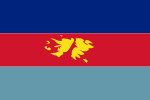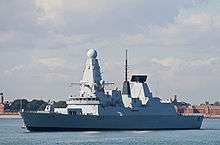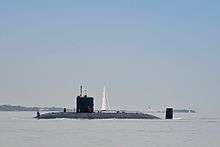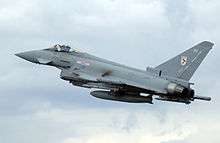Military of the Falkland Islands
The Falkland Islands are a British overseas territory and, as such, rely on the United Kingdom for the guarantee of their security. The other UK territories in the South Atlantic, South Georgia and the South Sandwich Islands, fall under the protection of British Forces South Atlantic Islands (BFSAI), formerly known as British Forces Falkland Islands (BFFI), which includes commitments from the British Army, Royal Air Force and Royal Navy.[3] They are headed by the Commander of the British Forces South Atlantic Islands (CBFSAI).[4]
| British Forces South Atlantic Islands | |
|---|---|
 The British Joint Forces flag flown in the Falklands[1] | |
| Allegiance | United Kingdom |
| Branch | Joint Service (Royal Navy, British Army, Royal Air Force) |
| Size | 1,350[2] in 2012 |
| Part of | Ministry of Defence |
| Commanders | |
| Commander British Forces South Atlantic Islands | Brigadier Nick Sawyer |
| Aircraft flown | |
| Fighter | Eurofighter Typhoon |
| Transport | Airbus A400M Atlas C1, Voyager KC2 & Chinook HC.4. |
Argentina invaded and took control of the Falklands on 2 April 1982. After recapturing the territory in June 1982, the UK invested heavily in the defence of the islands, the centrepiece of which was a new airfield at RAF Mount Pleasant, 27 miles (43 km) west of Stanley.[5] The base was opened in 1985, and became fully operational in 1986.[6]
Falkland Islands Defence Force
The Falkland Islands maintains its own part-time volunteer force, the Falkland Islands Defence Force (FIDF), previously known as the Falkland Islands Volunteer Corps. Although this unit existed in 1982 as a reinforcement for the Governor's detachment of Royal Marines, it did not play any part in the main conflict during the war of 1982, its members having spent the duration of the hostilities under house arrest by the Argentines after their surrender on the Argentine capture of the islands.[7][8][9] The FIDF is now a company-strength light infantry force with a permanent training Warrant Officer seconded from the Royal Marines. The FIDF operates in a number of roles and is fully integrated into the defence scheme for the islands. The FIDF has been trained by the Royal Navy to operate Oerlikon 20 mm cannon and to board vessels suspected of fishery poaching.[10]
Royal Navy

RAF Mount Pleasant has its own port facility[11] called Mare Harbour, operated by Naval Party 2010 (NP2010). The Royal Navy has a formal commitment, through Atlantic Patrol Tasking (South), to maintain a potential presence in the area with a frigate or guided missile destroyer accompanied by an RFA vessel in the South Atlantic. However as of 2019, HMS Lancaster was the last frigate to deploy on this tasking in 2015[12] and, in practice, an offshore patrol vessel, currently HMS Forth, is the principal presence permanently close to the islands.[13] In addition, an Ice Patrol Ship, HMS Protector, is on station close to Antarctica for six months of the year.[14]
When deployed, the major warship and RFA vessel carry out the Atlantic Patrol Task (South) mission, which "provides a maritime presence to protect the UK's interests in the region". The Type 42 destroyer HMS Edinburgh took over the South Atlantic Patrol Task in October 2006,[15] replacing HMS Southampton. Prior to Southampton's deployment in August 2005, the role was filled by HMS Cardiff, which was decommissioned on return to the UK. As of February 2010, the on-station warship was the Type 42 destroyer HMS York. In late April 2010, HMS York was relieved by the Type 23 frigate HMS Portland. In August 2010, HMS Portland was relieved by the Type 42 destroyer HMS Gloucester. On 21 April 2011, HMS York arrived at the East Cove Military Port in the Falkland Islands, beginning patrol duties for the islands.[16] October 2011 saw the arrival of the Type 23 frigate HMS Montrose, generating a statement from UNASUR (Union of South American Nations). The Type 45 guided missile destroyer HMS Dauntless replaced HMS Montrose as of April 2012.[17] In early August 2013, HMS Richmond was deployed to be the ship for the Royal Navy's Atlantic Patrol. HMS Portland was again deployed in January 2014 and HMS Lancaster deployed in 2015.
The Falkland Islands Patrol ship is an updated River-class patrol vessel, which arrived in the Islands in January, 2020, and is expected to be on station for a decade or more.[18] The previous Patrol ship, HMS Clyde, a River-class patrol vessel, had returned to Britain in late 2019 for decommissioning, after having relieved the Castle-class patrol vessels HMS Dumbarton Castle and HMS Leeds Castle in 2007.[19][20]
The Royal Navy also has Trafalgar and Astute-class nuclear submarines that it can deploy to the area, though such deployments are classified. The threat from submarines to hostile ships was demonstrated during the Falklands War when HMS Conqueror sank the Argentine cruiser ARA General Belgrano. The Royal Navy's submarines also carry BGM-109 Tomahawk cruise missiles, which have a range of 1,500 miles (2,400 km) and can strike at targets within an enemy country. In February 2012, a Trafalgar-class nuclear submarine may have been deployed to the Falkland Islands.[21]
British Army

The British Army maintains a garrison on the Falkland Islands based at Mount Pleasant. The total deployment is about 1,200 personnel made up of a roulement infantry company, an engineer squadron, a signals unit (part of the Joint Communications Unit – see below), a logistics group and supporting services.[22][23][24]
Ground-based air defence of RAF Mount Pleasant is provided by a detachment from the British Army's 16 Artillery Regiment equipped with the Rapier FSC surface-to-air missile system. Rapier is to be replaced in the early 2020s with the new Sky Sabre surface-to-air missile system incorporating an expanded capability.[25]
The British Army contributes to the Joint Service Explosive Ordnance Disposal group (see below) in the Falkland Islands, providing 33 Engineer Regiment (EOD) and RLC EOD teams.[26] This has been reduced to a team of 11 personnel.[27]
Royal Air Force
.jpg)
RAF Mount Pleasant was built in 1985 with the capability of accepting large trans-Atlantic aircraft such as the Lockheed TriStar. The TriStar was purchased mainly for the UK-Falklands route; until their entry into service, the UK used leased 747s and 767s.[28]
Originally Lockheed Hercules C.1K were used for air-to-air refuelling missions, but these were later replaced by a VC10. On 31 August 2013 the VC10 was replaced by a TriStar K.1 which was itself replaced by a Voyager KC.2 in February 2014. When a fighter is launched, it is almost immediately followed by the tanker as changeable weather conditions might make diversion to another airfield necessary. The Voyager however will be unable to fit within a hangar at RAF Mount Pleasant.[29]
Four Typhoon aircraft provide air defence for the islands and surrounding territories and have a secondary ground attack role.
The helicopters of No. 1564 Flight (formerly No. 78 Squadron) provided air transport missions. The Sea Kings carried out short and medium range search and rescue missions, until their retirement. AAR Corp was awarded a contract for helicopter search and rescue services in the Falkland Islands to replace 1564 Flight, using AgustaWestland AW189 helicopters in the role from 2016.[30] In March 2015, the UK announced that a pair of Chinooks would be stationed in the Falklands again, the first of which started flying in June 2016.[31][32] 1564 Flight disbanded in March 2016.[33]
A C-130 Hercules was used for transport, search and rescue and maritime patrol until replaced with an A400M Atlas C1 in April 2018.
Organisation
Joint Service
The Joint Communications Unit Falkland Islands (JCUFI) provides the electronic warfare and command and control systems for the Royal Navy, Army and RAF stationed there. It incorporates the Army's signals unit and RAF personnel.[38]
Joint Service Explosive Ordnance Disposal in the Falkland Islands consists of 33 Engineer Regiment (EOD), RAF and RLC EOD teams. It is mainly based in Stanley, but there is also a detachment at Mount Pleasant. The groups operates the Joint Service Explosive Ordnance Disposal Operations Centre. The group destroys munitions from the Falklands War that did not explode at the time and briefs troops, tourists and citizens on the areas that are safe and the minefield markings that have been put in place.[26][39]
Augmentation forces
The UK maintains a Joint Rapid Reaction Force, which contains elements of all three services, that could be deployed to the islands in the event of receiving intelligence of a specific threat to the islands.
Commanders
The following have served as Commander British Forces Falkland Islands/South Atlantic Islands:
- General Sir Peter de la Billière (1984–85)[40]
- Air Marshal Sir John Kemball (1986)[41]
- Rear Admiral Christopher Layman
- Major General A. Neil Carlier
- Air Vice Marshal David Crwys-Williams (1988–89)[42]
- Major General Malcolm Hunt RM
- Air Vice Marshal Peter Beer
- Air Commodore Ray Dixon (1998–99)
- Brigadier David Nicholls (1999)[43]
- Brigadier Geoff Sheldon (2000)[44]
- Air Vice Marshal John Cliffe (2001)
- Vice Admiral Sir Richard Ibbotson (February 2002)[45]
- Brigadier James Gordon (December 2002)
- Brigadier Anthony Wilson (2003)
- Air Vice Marshal Richard Lacey (2004)[46]
- Rear Admiral Ian Moncrieff (2005)[47][48]
- Brigadier Nick Davies (2007)[49]
- Air Commodore Gordon Moulds (2008)
- Commodore Philip Thicknesse (2009)[50]
- Brigadier William Aldridge (2011)[51]
- Air Commodore Russell La Forte (2013)
- Commodore Darren Bone RN (2015)
- Brigadier Baz Bennett (2017)[52]
- Brigadier Nick Sawyer (December 2018)[53]
British Forces South Atlantic Islands installations
| Name | Region | Opened | Description |
|---|---|---|---|
| Mount Pleasant Complex[54] | East Falkland | 1985 | HQ for British Force South Atlantic Islands with approximately 1000 Joint Service personnel permanently deployed. |
| Falklands Defence Force HQ, Stanley[55] | East Falkland | ||
| Mare Harbour | East Falkland | ||
| RAF Mount Alice | West Falkland | One of two early-warning and airspace control radar sites on West Falkland. | |
| RAF Byron Heights | West Falkland | One of two early-warning and airspace control radar sites on West Falkland. | |
| RAF Mount Kent | East Falkland | An early-warning and airspace control radar site on East Falkland. | |
See also
- RAF Mount Pleasant - British Army and RAF base
- Mare Harbour - Royal Navy base
- List of British Army installations
Sources
- Flags of the World. "Falkland Islands". Archived from the original on 16 October 2006. Retrieved 23 September 2006.
- "Military personnel in Falkland Islands totals 1.060, says MoD". Merco Press. Retrieved 26 September 2015.
- Permanent Joint Headquarters. "British Forces South Atlantic Islands". Archived from the original on 13 May 2006. Retrieved 19 June 2006.
- Falkland Islands Information Portal. "Acronyms". Archived from the original on 19 June 2006. Retrieved 19 June 2006.
- "Distance between London united kingdom and Port Stanley falkland islands (islas malvinas)". mapcrow.info. Retrieved 26 September 2015.
- Falkland Islands Government. "Defence". Archived from the original on 5 May 2006. Retrieved 19 June 2006.
- Falkland Islands Information Portal. "Falkland Islands Defence Force: 150 years of Voluntary Service". Archived from the original on 27 April 2006. Retrieved 19 June 2006.
- Land Forces of Britain, the Empire and Commonwealth. "Falkland Islands Defence Force". Archived from the original on 27 May 2006. Retrieved 19 June 2006.
- Falkland Islands Rifle Association. "History". Archived from the original on 13 December 2006. Retrieved 19 June 2006.
- "Defense & Security Intelligence & Analysis: IHS Jane's - IHS". janes.com. Retrieved 26 September 2015.
- Falkland Islands Portal. "Defence". Archived from the original on 26 April 2006. Retrieved 19 June 2006.
- https://www.savetheroyalnavy.org/a-history-the-royal-navys-falkland-islands-patrol-vessels/
- "HMS FORTH". MoD. Retrieved 7 January 2020.
- Michael Powell. HMS Protector will be Endurance replacement. Archived 15 January 2011 at the Wayback Machine The News. Portsmouth, 11 January 2011
- MOD. "HMS Edinburgh News". Archived from the original on 1 November 2006. Retrieved 6 November 2006.
- Archived 29 April 2011 at the Wayback Machine
- "HMS Dauntless destroyer deployed to Falklands by navy". BBC News. 31 January 2012.
- "FALKANDS-BOUND FORTH HERALDS NEW ERA FOR PATROL SHIPS". MoD. Retrieved 7 January 2020.
- "SAILORS AND ROYAL MARINES KEEP BRITAIN SAFE OVER CHRISTMAS". Royal Navy. 20 December 2019. Retrieved 21 December 2019.
- [royalnavy.mod.uk/news-and-latest-activity/news/2019/december/20/191220-hms-clyde-homecoming "HMS CLYDE'S LAST DRIVE HOME FOR CHRISTMAS"] Check
|url=value (help). Royal Navy. 20 December 2019. Retrieved 21 December 2019. - Archived 7 February 2012 at the Wayback Machine
- British Army. "Falkland Islands". Archived from the original on 15 June 2006. Retrieved 19 June 2006.
- Royal Logistic Corps. "Falkland Islands". Archived from the original on 17 January 2006. Retrieved 19 June 2006.
- Ministry of Defence. "Falkland Islands HIVE". Archived from the original on 14 June 2006. Retrieved 19 June 2006.
- https://www.army-technology.com/features/sky-sabre-inside-uks-missile-defence-system/
- Royal Engineers. "Joint Services Explosive Ordnance Disposal in the Falkland Islands". Archived from the original on 11 June 2006. Retrieved 19 June 2006.
- "Minutes" (PDF). The Royal Engineers Association. 29 January 2014. Archived from the original (PDF) on 24 September 2015. Retrieved 26 September 2015.
- Royal Air Force. "Mount Pleasant, Falkland Islands". Archived from the original on 20 June 2006. Retrieved 19 June 2006.
- "Future Strategic Tanker Aircraft". theyworkforyou.com. Retrieved 26 September 2015.
- "AAR Awarded 10-Year Search & Rescue Contract in the Falkland Islands by UK MOD - General News - News - AAR Corporate". aarcorp.com. Retrieved 26 September 2015.
- https://www.bbc.com/news/uk-politics-32031342
- http://www.janes.com/article/61986/uk-returning-chinooks-to-falkland-islands
- "Archived copy". Archived from the original on 4 April 2016. Retrieved 3 April 2016.CS1 maint: archived copy as title (link)
- "RAF Retires TriStar Tankers As Voyager Fleet Grows". Aviation International News. Retrieved 26 September 2015.
- https://twitter.com/FalklandsinUK/status/978991266141581312
- "Clyde catches the whirlybird during demanding aviation training in the Falklands". Royal Navy. 11 October 2016. Retrieved 15 January 2016.
- "FOIA 2017/1418" (PDF). gov.uk. 24 February 2017. Retrieved 29 July 2017.
- Royal Corps of Signals. "Falkland Islands". Archived from the original on 29 March 2005. Retrieved 19 June 2006.
- CISR. "James Madison University - Our work improves lives". jmu.edu. Retrieved 26 September 2015.
- "Britain's Small Wars". britains-smallwars.com. Archived from the original on 29 August 2014. Retrieved 26 September 2015.
- "AROUND THE WORLD; Falkland Islands Mark 4th Anniversary of War". The New York Times. 16 June 1986.
- "Brigadier David Nicholls". The Daily Telegraph. 22 July 2006. Retrieved 26 September 2015.
- Archived 21 August 2008 at the Wayback Machine
- Archived 7 February 2012 at the Wayback Machine
- "Chilean General Did Everything to Help the British Win in 1982 - Falkland Islands News". sartma.com. Retrieved 26 September 2015.
- "Chilean General Did Everything to Help the British Win in 1982 - Falkland Islands News". sartma.com. Retrieved 26 September 2015.
- "Penguin News Update". MercoPress. Retrieved 26 September 2015.
- Archived 18 February 2012 at the Wayback Machine
- "Falklands' veteran, Commander of British Forces South Atlantic Islands". MercoPress. Retrieved 26 September 2015.
- "New Falklands' British Forces commander played key role in UK 2009 floods' rescue operations". MercoPress. Retrieved 26 September 2015.
- http://en.mercopress.com/2017/04/14/falklands-new-cbfsai-brg-bennett
- "Brigadier Nick Sawyer, new Commander British Forces South Atlantic Islands". MercoPress. 7 December 2018. Retrieved 28 December 2018.
- "Ministry of Defence - Defence For... - The Service Community - Overseas Posting - British Forces South Atlantic Islands - British Forces South Atlantic Islands (BFSAI)". Archived from the original on 26 October 2012. Retrieved 17 March 2016.
- "Home - FIDF". Retrieved 17 March 2016.


.jpg)